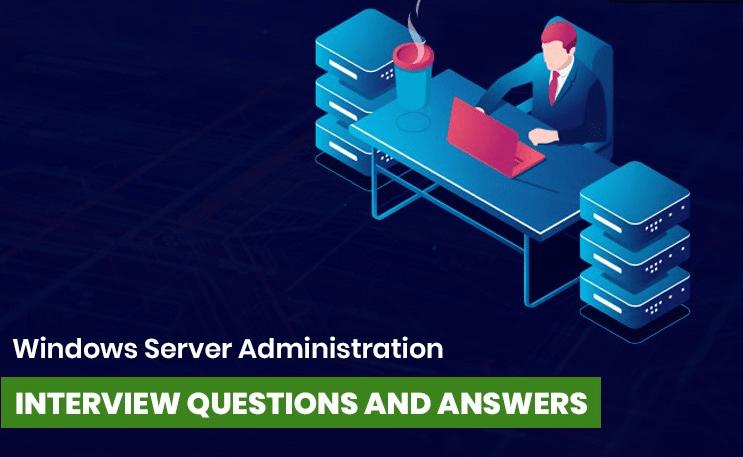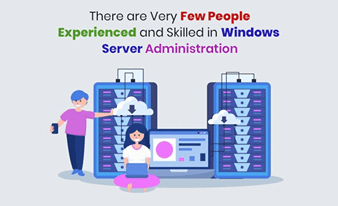
Top 25 Windows Server Interview Questions and Answers -2
1. What is Windows Server?
Windows Server is a brand name for a group of server operating systems released by Microsoft.
2. What is an Active Directory?
Active Directory is an organization of the inventory in a library to gather objects such as computers, customer profiles, etc. It effectively controls the framework through Domain Controllers that are available at many zones with the database of the Active Directory. A section of the limits fuse dynamic association with numerous land zones, check of computers and customers in the space offered by windows, using the Domain Controller to copy Active Directory. In accumulation to that these lines will be returned to every Domain Controllers.
3. Distinguish between a computer process and a thread.
Computer Process
In computing, a process is a computer program case that is performed repeatedly by a computer, that can run numerous programs on computer at the same time.
Thread
A thread comprises the many executable programs that collaborate as a solitary process. For instance, a thread might send a notification error to the customer; an alternative might contract with the signals of error although the third thread may perform the primary action.
4. What do you know about authorizing DHCP Servers in Active Directory?
In case, a DHCP server is to function in an Active Directory domain (and the domain controller is not used to running it) it should first be approved to Active directory.
5. What Is Group Policy?
Group Policy is a Microsoft Windows NT feature that is also a family of OS that manages the work setting of computer accounts and user accounts. Group Policy offers the central configuration management and of OS, users’ settings, and applications in an Active Directory setting.
6. List flexible single master operations (FSMO) roles by Windows Server?
Following are some of the roles of FSMO:
Infrastructure Master
Schema Master
PDC
RID Master
Domain Naming Master
7. What do you understand by domains, forests and trees?
The rational units of any organization of Active Directory are usually called tree, domain, and forest. Various articles in the procedure of a rational section join accompanying: customers, computers, devices, etc. that share an analogous active database registry that is normally known as a “domain”.
A tree is an assortment of domains in the Active Directory that starts at one root and branches out into child domains, peripheral. This might similarly comprise an adjoining namespace linked in a transitive order.
The domains collection is often known as “forest” that shares general logical structure, inventory, registry pattern and registry setup. It typifies the limits of security for groups, clients, and devices for example computers.
8. What is Group Policy Objects (GPO) and list different kinds of GPO?
The setting that controls the client records the workplace, and also computer records, are called Group Policy Object (GPO). This help is describing the programming establishment, security alternatives, upkeep choices and library-based arrangements, folder redirection choices and content choices. There are usually 2 categories of GPO:
Local GPO: These are put away on close devices.
Nonlocal GPO: These are available on Active Directory and are put away on a domain controller.
9. Can we link third-party Directory service to an Active Directory?
Yes, why not, it is possible to link third-party directory services to Active Directory with by using different versions of Microsoft. dirXML or LDAP can be used to link Active Directory to other retailers.
10. What commands you will use to check TCP/IP configurations?
The 2 most often used check TCP/IP configurations commands are:
Ipconfig: To check the IP setup of the computer, we can use the command Ipconfig and additionally it can be very well applied to reestablish the IP address of the users if it is specified by a DHCP server.
Ping: To check the link among the computer in use and the other computers, we can use the Ping command.
11. What is the domain controller’s basic function?
The domain controller function is to verify customers to many networks and bring a set of objects that involved the Active Directory.
12. What is the goal of installing local DNS servers?
A local DNS server offers the local mapping of fully competent domains to IP addresses. To resolve requests concerning the domains on network, local DNS servers can offer record data to distant DNS servers.
13. What’s new in Windows Server 2019?
It is the latest window server version that uses the shortened LTSC or long-term servicing channel. Some of the most dominant features if the new windows server 2019 are:
- Support for Kubernetes
- Storage Space Direct
- Storage Replica
- Improved Windows Defender
- Windows Subsystem for Linux
- Other GUI new features from Win10 version 1809
- Storage Migration Service
- System Insights

14. What is Windows Server’s default user interface?
Windows PowerShell is said to be the default user interface and command-Line Shell made by Microsoft. The main goal of the PowerShell is to systematize administrative tasks that work both remote and local windows machines. .NET Framework is used to build PowerShell.
15. What is INODE?
The file’s metadata are kept by INODE holds; INODE is said to be a unique pointer to a disk block. You can also say that it is a unique number owed to a file in UNIX-like Operating system.
16. Explain what is RAID in Windows Server?
For storing the same data at a different place RAID or Redundant Array of Independent Disks strategy is used. It is a strategy for building fault tolerance and increase storage capacity. On separate drives it allows you to combine one or more volumes so that they are accessed by a single drive letter.
17. What Are the System Administrator Roles?
The System Administrator role varies in the organization. The 2 key System Admin tasks are Supporting, Installing and maintaining computers & servers.
- Install patches & OS Updates
- Access user’s administration
- Creating and Restoring system backups
- Access control
- Review system logs access administration
- Planning Disaster recovery
- Comply with password needs
- System audit logging
18. Can you name Different Version of Windows Server?
The version of windows servers till now are:
- Windows Server 2003 (2003)
- Windows Server 2003 R2 (2005)
- Windows Server 2008 (2008)
- Windows Server 2008 R2 (2009)
- Windows Server 2012 (2012)
- Windows Server 2012 R2 (2013)
- Windows Server 2016 (2016)
19. What is the global catalog?
The Global Catalog is a kind of database that comprises all of the data relating to objects in Active Directory environment domains.
20. Explain the difference between local, universal and global groups?
Domain local groups allocate access approvals to international groups of domains for local resources of the domain. Global groups offer access to other trusted domains’ resources. The Universal groups grant access to all trusted domains resources.
21. Can Active Directory Partitions Be Restored?
We can authoritatively restore the objects from domain and configuration partition. Authoritative restores of schema-naming are not supported here.
22. Explain different types of active directory partitions.
Configuration Partition– it is a partition that stores all the data of Active Directory. The data comprises site-link, Site, subnet etc. This partition copies all domain controllers that are available in the Forest.
Application Partition– it stores the information of applications in Active Directory. For examples DomainDNSZones and ForestDNSZones.
Schema Partition–It stores all the information of the objects and their qualities; it copies to other domain controllers in the Forest
Domain Partitions– it stores the domain information that includes a computer, user, printer, group, etc. It also copies to all domain controllers in the domain.
23. What is a Proxy Server?
It is a computer that is actually a doorway between a local network (such as all computers in one organization or in a building) and a larger-scale system such as the Internet. Proxy servers offer increased security and performance. In most of the cases, they monitor employees using outside resources.
24. What is WINS server?
Windows Internet Name Service (WINS) servers map the IP addresses to NetBIOS names. This lets employers access resources by name of the computer rather than the IP address. To keep a check on the IP addresses and names of other computers network, this computer can be configured as a WINS server.
We may not able to connect to a remote network through its NetBIOS name, in case you are not using WINS in a network.
25. Define Dora Procedure & its usage.
Discover, request, Offer and acknowledgement. it is used to automatically allocate an IP address to systems of the client.
